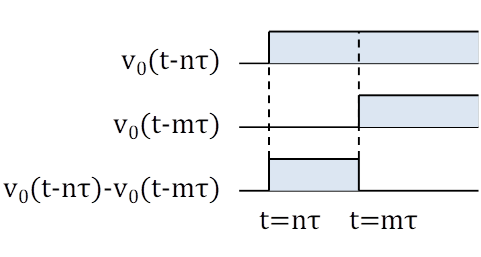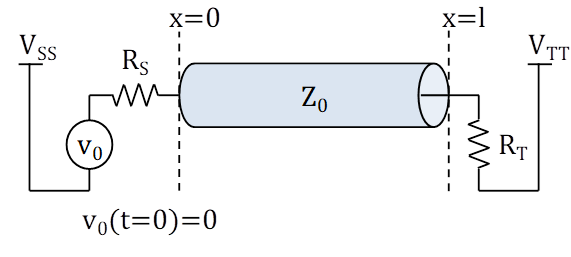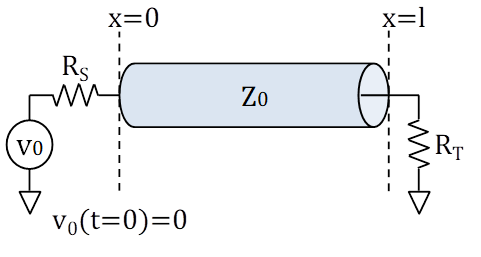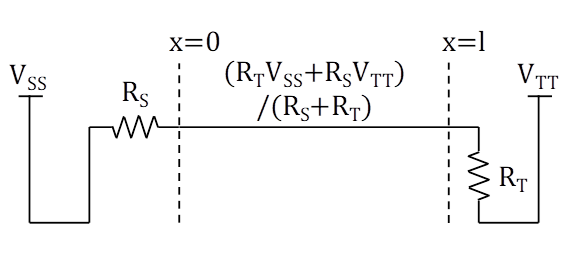Multiple reflection in a terminated line
|
A transmission line is terminated by RS and RT at the source and termination end respectively.
The voltage and current at the source end are
The voltage and current at the termination end are
where Ń is the propagation delay and ĄS,ĄT are the reflection coefficients.
Assuming the input voltage v0(t) is a rising step.
The voltage and current at the source end are
The voltage and current at the termination end are
|
We will derive a special solution for a terminated line.
***

We assume the boundary conditions at the source and termination end as
![]()
Laplace transformed boundary conditions are
![]()
Inserting general solutions
![]()
![]()
into the boundary conditions, we obtain the equations in terms of Va and Vb
![]()
![]()
Combining like terms:
![]()
![]()
Using the propagation delay Ń and reflection coefficients ĄS,ĄT instead of l and RS,RT,
![]()
then
![]()
![]()
Eliminating Vb, we obtain Va
![]()
Here we expand 1/(1-x) to move the factor exp(-2Ńs) from the devisor to dividend. This geometric series represents the multiple reflection.
Substituting the Va and Vb into the general solutions, we obtain the special solutions in the 's' domain
![]()
![]()
Noting that multiplying exp(-Ńs) in the 's' domain is equivalent to shifting by Ń(>0) in the time domain
![]()
![]()
,then we obtain the special solutions in the time domain.
![]()
![]()
***
The voltage and current at the source end (x=0) are
![]()
![]()
![]()
![]()
These solutions satisfy the boundary condition.
![]()
***
By noting l/u=Ń, the voltage and current at the termination end (x=l) are
![]()
![]()
![]()
![]()
These solutions satisfy the boundary condition.
![]()
***
We assume that the input voltage v0(t) is a rising step.
![]()
Using the identity:
![]()
, the voltages can be expressed in terms of the amplitude in nŃ< t <mŃ: v0(t-nŃ)-v0(t-mŃ)

At the source end:
![]()
At the terminaton end:
![]()
or, explicitly
At the source end:
![]()
At the terminaton end:
![]()
Moreover expressing the amplitude in terms of RS,RT and Z0,
At the source end:
![]()
![]()
![]()
At the terminaton end:
![]()
![]()
![]()
***
So far we have assumed the initial condition as v(x,0)=0,i(x,0)=0. When the source voltage VSS or termination voltage VTT is not zero,

we may just superpose the DC circuit.


Then the solution is just shifted by constant.
![]()
For example, a transition from HIGH(VSS) to LOW(0V) is equivalent to a transition from 0V to negative voltage.

